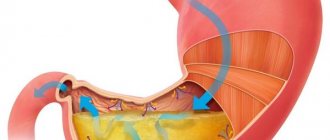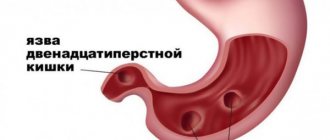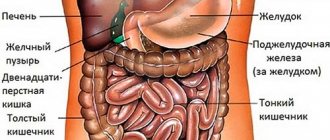The main components of gastric juice
The composition of human gastric juice includes numerous components: enzymes, hydrochloric acid, mucus, substances of protein structure. Each component has its own purpose. The coordinated work of the juice components ensures the processing of complex compounds that comprise food into simple ones.
A significant role in the digestion process is given to 5 main substances:
- Hydrochloric acid is an important component of digestive juice. It is responsible for maintaining normal acidity inside the stomach and promotes the conversion of pepsinogen into pepsin. HCl provides reliable protection against viruses and bacteria. Most pathogenic microorganisms cannot withstand an acidic environment and die.
- Bicarbonates are involved in the HCl neutralization reaction. Aggressive hydrochloric acid can have a damaging effect on the surface of the mucous membrane of the stomach and duodenum. Bicarbonates protect the mucous membrane.
- Pepsinogen is the precursor of pepsin. Under the influence of the latter, proteins are broken down. Produced by the chief cells of the mucosa.
- Mucus provides reliable protection to the inner lining of the stomach from aggressive juice components (pepsin and hydrochloric acid). It is found in two states: as part of gastric juice and forms a thick layer of gel on the walls of the stomach with a concentration of bicarbonates. They neutralize HCl. Thus, the inner surface of the stomach has mechanical (impenetrable to pepsin) and chemical protection (neutralization of acid). Mucin is constantly consumed and continuously formed due to the active work of accessory cells and glands.
- Castle's intrinsic factor is an enzyme that specializes in activating vitamin B₁₂. The secretion is formed and concentrated in the parietal cells of the fundic glands.
Violation of the secretion of any component of digestive juice can result in the development of chronic gastrointestinal diseases, but the stomach itself will suffer first.
What happens with low acidity
Hyposecretion of gastric juice is much less common. Do not assume that this condition is better (based on information obtained from television advertising). On the contrary, gastric hypofunction is much more dangerous.
Some people do not know how much acid a person should produce, and they believe that the less it is, the better, because then “there will be no heartburn.” The mechanism of the stomach is such that for its normal function, its secretion must have an acidic reaction. If little acid is produced, gastric activity decreases, and many disease-causing organisms can enter the body.
What does a person feel with low acidity? There is no need to think that this changes the color of the gastric discharge. It has reduced enzymatic properties, which contributes to the appearance of the following symptoms:
- a sharp drop in appetite;
- belching with an unpleasant odor of spoiled eggs;
- bad odor coming from the mouth and not going away after brushing your teeth;
- constipation;
- signs of intestinal upset;
- nausea, worse after eating;
- the presence of helminths in the stomach or intestines (they are not neutralized by acid);
- flatulence.
Interesting! What are the causes of nausea and vomiting of gastric juice?
The danger of this condition is as follows:
- due to a decrease in the intensity of digestive processes, a large amount of food accumulates in the body
- amount of decomposition products;
- decreased absorption leads to anemia, hair loss, etc.;
- the development of autoimmune pathologies and even cancer;
- the appearance of allergic reactions even to once familiar products;
- due to a decrease in the effect of gastric juice on proteins, the patient may develop protein starvation;
- decrease in blood pressure.
To treat this condition, it is necessary to choose a therapy that gives the juice normal acidity. Sometimes the patient needs to consume hydrochloric acid preparations.
The role of gastric juice in digestion
In the process of digestion, the stomach becomes the main source of food after the oral cavity. The muscular organ, together with enzymes, performs important functions.
We will briefly and clearly describe the role of gastric juice in digestion point by point:
- Due to pepsins, large protein molecules are broken and polypeptide chains consisting of protein compounds are formed. This is the initial stage in the digestion of proteins. At this stage, absorption does not occur, but protein molecules swell and lose strength, which in the future will allow them to finally turn into amino acids under the action of the glands of the small intestine and pancreas.
- Gastric juice is characterized by a slight lipolytic effect. This means that under its action the emulsified fats of mother's milk in newborns are broken down. For an adult, this function is not of great importance.
- Digestive juice has antimicrobial properties. It prevents the further “travel” of bacteria that enter the stomach with food through the digestive tract.
Secretion of gastric juice
Phases of gastric secretion
Complex reflex phase (brain)
Outside of the digestive process, the stomach does not contain typical gastric juice, but only a small amount of alkaline liquid without enzymes. Gastric juice begins to be released only when eating or during irritation that previously accompanied the act of eating (conditioned reflex). The act of eating and swallowing, during which the receptors of the oral cavity and olfactory region are irritated, provides the most important stimuli for secretion.
In the experience of imaginary feeding, a few minutes after the start of food from the gastric fistula, although the food does not enter the stomach, the secretion of juice begins, first in the form of drops, and then in a thin stream. During the experiment, up to a liter of gastric juice can be collected from a large dog. The separation of gastric juice in such an experiment also occurs at the sight, smell of food, etc., i.e., upon stimulation of the corresponding areas of the cerebral cortex. This phase of gastric secretion is called cerebral or complex reflex. It is characterized by a strong and steep rise in the juice secretion curve, and after reaching a rather sharp peak, it falls sharply and ends by the second hour. Material from the site https://wiki-med.com
Neurohumoral phase (chemical)
But if this phase of juice secretion is excluded by filling the dog’s stomach with food through a fistula, unnoticed by the dog, then juice secretion occurs differently: after a longer latent period than during the reflex phase, it increases slowly, does not reach the maximum and slowly subsides by 4-5 hours . It turned out that mechanical irritation of the stomach by food is of some importance here, but this is mainly due to the chemical influence of food extractives, which are gradually extracted from food, and the products of digestion of proteins - peptones and albumosis. These substances are absorbed into the blood and act on the glands of the stomach, being brought to them by the blood. Proof may be the introduction of such substances directly into the blood. These experiments suggest that after the first phase of juice secretion, the second phase will emerge - chemical, or neurohumoral, which in turn is divided into the gastric and intestinal phases of gastric secretion. In the feed of farm animals, extractive substances are contained in plants, especially young ones (in grass harvested before flowering). These are obviously aromatic acids and aromatics. There are many such substances in silage.
Features of gastric secretion for different types of food
The method of isolated ventricle, but Pavlov, allows us to establish the characteristics of the secretion of gastric glands with various types of food (p. 16).
Meat
So, when eating meat, the juice secretion curve increases very quickly, remains at a high level for 2-3 hours, and then quickly decreases. This is due to the fact that meat contains a lot of extractive substances, meat proteins are easily digested and protein breakdown products quickly appear - all this stimulates secretion. On the other hand, the meat quickly leaves the stomach and secretion stops.
Bread
When eating bread, secretion, having reached its maximum in the first hour, then begins to fall sharply, but lasts longer than when eating meat. This is explained by the fact that there are fewer extractive substances in bread, and bread proteins are digested slowly and their breakdown products appear late. Therefore, having reached its maximum due to the reflex phase, in the chemical phase, juice secretion occurs weakly, but for a long time.
Categories: Biological fluids Gastrointestinal tract Digestion Stomach
On this page there is material on the following topics:
What are the names of the cells that secrete gastric juice?
what experiment established the second chemical phase of gastric juice secretion
main elements of gastric juice abstract
gastric juice begins to secrete when
the dog is secreting gastric juice through the fistula, why can’t this happen?
Material from the site
Where is gastric juice produced?
Science has long known how and what gastric juice produces. It is formed as a result of the activity of the entire pool of secretory cells of the organ mucosa. An adult produces about 2 liters of fluid in 1 day. There are several types of cells that synthesize gastric juice. They differ in localization:
- Acid-producing cells are located throughout the body and fundus of the stomach. They occupy about 80% of the area of the hollow organ. Clusters of cellular elements form depressions on the surface of the mucous membrane. They are called gastric pits, which are formed by chief, parietal and mucoid cells. The former secrete pepsinogen. Parietal cells produce HCl. Accessory or mucoid are responsible for the synthesis of bicarbonates and mucus.
- A small part of the cellular elements falls on the antrum of the stomach. They specialize in producing mucus to protect the inner lining from aggressive factors.
Each cell of the stomach performs a specific role. Violation of its anatomy and physiology results in gastrointestinal diseases.
Zones of acid production and neutralization in the stomach[edit | edit code]
The gastric stage of food digestion occurs with the help of enzymes, the most important of which is pepsin, which necessarily require an acidic environment. However, the acid in chyme (gruel), consisting of partially digested food and gastric juices, must be neutralized before being evacuated from the stomach.
The stomach can be conditionally divided into acid-forming (upper) and acid-neutralizing (lower) zones, separated by an intermediate zone, that is, a zone of transition from slightly acidic pH (6.0-4.0) to strongly acidic (pH less than 3.0) and located between body of the stomach and its antrum.
Since when studying the acidity of the stomach, information about the processes of acid production and acid neutralization is diagnostically important, the measurement of stomach acidity should take place in at least two zones: the body of the stomach and the antrum.
Neutralization of acid in the stomach is carried out mainly due to bicarbonate ions (HCO3-) secreted by the surface cells of the mucous membrane.
Physicochemical properties of gastric juice
A few facts about gastric juice:
- Normally, there is a sour odor of gastric contents. It may vary depending on the amount of HCl. With a low level of hydrochloric acid and the presence of fermentation products, the smell resembles the evaporation of organic acids. For example, milk or vinegar. If the stomach contents smell rotten, it means the person is suffering from cancer.
- The digestive juice of the stomach is almost colorless. A yellowish tint appears in the presence of low acidity, achylia. Green color indicates a high level of hydrochloric acid and the presence of bile. Red and brown coloration indicates the presence of blood.
- A moderate amount of mucus is normal. Its volume changes with gastritis with low acidity (hypertrophic, atrophic).
- The volume of the stomach on an empty stomach ranges from 0 to 50 ml.
The listed characteristics play an important role in the diagnosis of pathology of the gastrointestinal tract. By changes in the physicochemical composition of gastric contents, one can judge the pathology of the digestive system.
Three phases of hydrochloric acid secretion[edit | edit code]
- The secretion of hydrochloric acid begins even before food enters the stomach. The first phase of secretion (the so-called cephalic) is triggered by the smell, sight and taste of food, the effect of which is transmitted from the central nervous system to the cells of the stomach through the nerve endings innervating the stomach.
- The most significant phase of secretion is gastric, which begins after food enters the stomach. Distension of the stomach triggers the release of gastrin from G cells located in the antrum of the stomach. Gastrin, acting on parietal cells directly or through activation of ECL cells with the release of histamine, stimulates the production of hydrochloric acid.
- The final phase of secretion - intestinal - is triggered when food enters the duodenum and stretches it.
An increase in the acidity of gastric juice turns on a mechanism for regulating secretion: in the cells of the antrum of the stomach, the production of somatostatin, a blocker of hydrochloric acid secretion, is triggered.
Chemical composition of gastric juice
An inquisitive patient or 8th grade student is interested in knowing what chemicals are part of gastric juice. After all, they trigger the basic mechanisms of digestion.
The liquid consists of two main components: water and dry. The dry residue is represented by organic and inorganic compounds.
Inorganic components include:
- water;
- chlorides;
- sulfates;
- phosphates;
- hydrocarbonates;
- ammonia.
Without the listed components of gastric juice, digestion is impossible.
Table 1. Inorganic composition of gastric juice and the role of components in the digestion process
| Substance | Concentration | Its function |
| HCl | Its concentration is 160 mmol/l | The chemical destroys pathogenic microorganisms. HCl creates acidic conditions necessary for enzymes to function |
| Phosphates | 10—60 mg/l | Participate in chemical processing of food |
| Sulfates | 10 mg/l | Have a similar effect |
| Chlorides | 5–6 g/l | pH regulation |
| Hydrocarbonates | 0—1.2 g/l | Takes part in chemical reactions to digest food and protect mucous membranes |
| Ammonia | 10 mg/l | Product of biochemical processes of stomach cells |
How is acid neutralized?
It is known that gastric juice consists of bicarbonates. Why is such a component included? Gastric juice begins to be released as soon as the corresponding reflex becomes active in a person. But this does not always depend on the ingestion of food. In this case, the acid will begin to damage the organ. To prevent this from happening, bicarbonate ions come to the rescue. The cells that produce it are called superficial.
Interesting! Conducting ph-metry of the stomach: indications and contraindications
The formula for such a reaction has been known to us since school. Under the influence of the ion, carbon dioxide and water are formed. What kind of environment is formed in this case? Bicarbonate gives the juice its alkaline properties.
Such properties can prevent throat burns or laryngeal burns when acidic contents reflux into the esophagus. This happens in many gastrointestinal pathologies.
What is the biochemical composition of gastric juice and its effect
The composition and significance of gastric juice depends on the secretion and activity of biochemical substances. Pepsins play an important role. They are necessary for the breakdown of complex protein structures into simple ones.
Each protein has a universal set of amino acids (AA). The combination of hundreds and thousands of AAs leads to the formation of a huge protein molecule. In order for cells to digest the bulky complex, it must be broken down. This task can be accomplished by special enzymes that are active at a temperature of 37–38 C°.
There are three types of pepsins:
- Pepsin A;
- Pepsin B;
- Pepsin C.
Their coordinated work contributes to the formation of simple substances that are easily digested by the gastrointestinal tract.
Gastric juice contains other enzymes - gastricin and gastric lipase. Due to the ingestion of food bolus, the environment in the stomach becomes alkalized. An important feature of gastricsin is the digestion of proteins in a less acidic environment, while pepsin becomes less active.
Table 2. Biochemical composition of gastric juice
| Substance | Meaning |
| Pepsin A | Most active at low pH. It breaks down proteins to form oligopeptides |
| Pepsin B | Specializes in the breakdown of gelatin (connective tissue protein) |
| Pepsin C | Promotes hydrolysis of hemoglobin and egg white |
| Lipase | Provides hydrolysis of emulsified fats |
| Gastricin | Participates in the breakdown of protein molecules under conditions of increased pH |
What enzymes are included in gastric juice?
The composition of gastric juice includes enzymes of proteolytic and non-proteolytic nature. The first group of substances specializes in protein hydrolysis. They break the bonds between protein structures to form simple peptides. Under the influence of non-proteolytic enzymes, fats are broken down.
A number of substances have proteolytic properties: rennin, pepsin, gastrixin, ATP, lactic acid, mucus, gastromucoprotein. The first three enzymes are characterized by a similar primary structure. They come from pepsinogen.
Non-proteolytic components include lipase. Necessary for the breakdown of emulsified milk fats. It is of particular importance for infants.
Table 3. Enzymes included in gastric juice
| Enzyme | What cells produce | Role |
| Pepsinogen | The enzyme is synthesized by fundic cells of the stomach | It is a precursor to pepsin. Pepsin is formed from pepsinogen with the help of HCl |
| Pepsin | Formed from pepsinogen | Breaks protein peptide bonds. Promote the formation of simple peptides |
| Gastricin | ||
| Chymosin | The main function is to curdle milk. Present in children in infancy. Interacts with an important component of milk called casein. During the reaction, an insoluble clot is formed, which is quickly removed from the stomach. In an adult, milk is curdled with the help of pepsin. | |
Castle Factor | Source: parietal cells | Transforms vitamin B₁₂ into an active form that can be absorbed into the gastrointestinal tract |
| Lipase | Substance secreted by chief cells | Necessary for the breakdown of emulsified fats |
| Lysozyme | The protein is formed as a result of the active activity of fundal cells | Has an antimicrobial effect |
What acid is included in gastric juice?
Hydrochloric acid is part of gastric juice. It is formed by the parietal cells of the organ.
According to anatomy, the gastric mucosa is divided into two areas. One is responsible for the production of HCl, the other for the synthesis of bicarbonates. The latter are necessary to neutralize hydrochloric acid. They prevent its negative impact on the sensitive gastric mucosa.
Interesting to know! Males have a higher percentage of parietal cells than females. And the production of hydrochloric acid is higher.
In percentage terms, HCl prevails over other acids several times. A high level of lactic acid may indicate insufficient formation of hydrochloric acid.
The concentration of HCl contained in gastric juice is 160 mmol/l. A highly concentrated solution could completely burn out the organ mucosa. Protective substances prevent an irreversible situation from occurring.
HCl is produced in three stages:
- The smell and taste of food causes the transmission of a nerve impulse to the cells of the stomach.
- When food stretches the walls of the stomach, the hormone gastrin is released. Under its influence, HCl is released by parietal cells.
- When digested food enters the duodenum, the hormone somatostatin is produced. It blocks the release of hydrochloric acid from cells.
What is the role of hydrochloric acid in gastric juice
The acid that is part of the gastric juice has the following functions:
- It promotes the breakdown of protein molecules and swelling.
- The acid activates pepsinogen, turning it into pepsin.
- The created acidic environment promotes the destruction of pathogenic microorganisms and better breakdown of proteins.
- Under the influence of HCl, the activity of the gastrointestinal tract is regulated. The enhancement or inhibition of nervous and humoral influences on the functioning of the gastrointestinal tract depends on the pH level.
Normal levels of the main component of gastric juice ensure the proper functioning of the digestive system.
Stomach acidity
The main indicator of the normal functioning of the stomach is the level of acidity, that is, the concentration of acid in the gastric juice. This indicator is measured in different parts of the stomach, esophagus and duodenum. Hydrochloric acid in the stomach breaks up complex molecules, which facilitates absorption in the small intestine.
The synthesis of acid in the stomach is less than the established indicators, indicating low acidity. With an increased level of acidity, the acid concentration exceeds the norm. In any case, a shift in this indicator triggers pathological changes in the gastrointestinal tract and causes the appearance of unpleasant symptoms.
Reduced or increased secretion of hydrochloric acid threatens the appearance of chronic gastritis, peptic ulcers and even cancer. Currently, there are a large number of ways to measure acidity levels, but the intragastric method is considered the most accurate and informative. During the day, the concentration of hydrochloric acid is measured simultaneously in several parts of the stomach. This happens with the help of devices that are equipped with special sensors.
Important! Stimulation of gastric juice for research is carried out using products that contain insulin or histamine.
The fractional probing technique is also used. The contents of the stomach are sucked out using a rubber tube. Compared with the previous method, the results of this study are not as accurate. This is due to the fact that biological material is taken from different zones and mixed.
Moreover, the research process itself disrupts the normal functioning of the stomach, and this also distorts the results obtained. Experts distinguish two main types of changes in acidity levels: increased and decreased types. Let's talk about these changes in more detail.
The analysis will show what acid is in the stomach
Increased acidity
Excessive production of hydrochloric acid manifests itself in the form of such unpleasant symptoms:
- heartburn. It usually appears after eating or taking a horizontal position. Heartburn is the result of stomach contents refluxing into the esophagus. Irritation of the mucous membrane is the cause of the burning sensation;
- sour or bitter belching. It appears when gases or food enter the esophagus;
- pain outbreak;
- feeling of heaviness and fullness in the stomach. Even a regular snack causes discomfort;
- decreased appetite;
- bloating;
- rumbling in the stomach;
- nausea, vomiting;
- constipation or diarrhea.
When the production of gastric juice is high, heartburn and an attack of pain occur. If there is high acidity, you should never neutralize it with soda. In the future, this will lead to an even greater increase in the secretion of gastric juice and the formation of deep ulcers on the mucous membrane.
A variety of factors can lead to excessive acidity: dietary errors, bad habits, stressful situations, taking medications. The development of hyperacid gastritis is also based on the influence of Helicobacter pylori infection. This is the only bacterium that is not damaged by hydrochloric acid.
Which component of gastric juice has a bactericidal effect?
The composition of the gastric juice of a healthy adult is unique, because it not only ensures the digestion of food, but also protects against pathogens.
Two substances in gastric juice have a bactericidal effect:
- hydrochloric acid;
- lysozyme
Lysozyme is a protein with bactericidal properties. It is found in saliva, tears, and gastric juice of all known vertebrate organisms. Protein acts on the microbial cell from the outside.
The mechanism of destruction of pathogenic bacteria is to disrupt the integrity of the peptidoglycan layer of the outer wall of the microorganism. Without an outer shell, the foreign agent dies.
Lysozyme is widely used in medicine for bacterial and viral diseases. A natural component of gastric juice kills harmful microorganisms. Recovery comes faster.
History of the study of gastric juice acidity[edit | edit code]
At the beginning of the 16th century, Paracelsus suggested the presence of acid in the stomach, believing that acid appears when drinking acidic water. The English physician and biochemist William Prout determined in 1824 that the acid contained in gastric juice is hydrochloric acid. He also introduced the concept of free
,
bound
hydrochloric acid and
total acidity of gastric juice
. In 1852, physiologist Friedrich Bidder and chemist Karl Schmidt published the book “Digestive Juices and Metabolism,” which laid the foundation for the titration method for determining the acidity of gastric juice and finally dispelled doubts that it is hydrochloric acid that is normally secreted by the stomach. Rigel in 1886 and Schüle in 1895 began to determine the acidity of gastric juice for the purpose of diagnosing and treating gastroenterological diseases.
One of the first to propose probing of gastric juice was the German doctor Adolf Kussmaul. The creation of clinical methods and gastric tubes for studying gastric secretion by aspiration methods (mainly by the efforts of the first gastroenterologists from Germany: Wilhelm von Leibe, Karl Ewald and Ismar Boas and the American trained in Germany Max Einhorn) actually formed a new medical discipline - gastroenterology.
Danish biochemist Søren Sørensen proposed the pH scale in 1909 and developed modern electrometric methods for measuring acidity. In 1915, the American chemist and physiologist Jesse McClendon first performed pH measurements in the human stomach and duodenum using a device of his own design.











